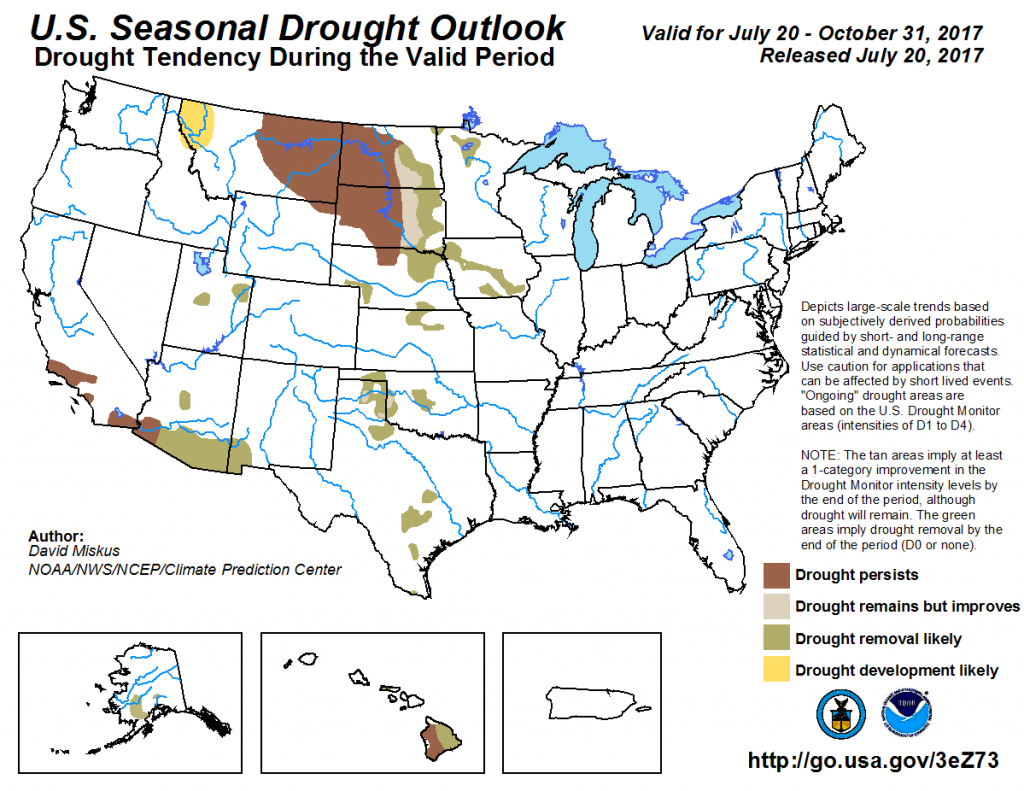31 July 2017
WASHINGTON, DC — The U.S. National Oceanic and Atmospheric Administration’s latest seasonal drought assessment, released on July 20, 2017, finds that since mid-June, drought coverage and intensity increased across the Great Plains and U.S. Southwest, especially in eastern Montana and the Dakotas, exacerbated by periods of intense heat, windy conditions, and low humidity. Drought also increased in southwestern Alaska and on the Big Island of Hawaii.

This graphic depicts the U.S. Seasonal Drought Outlook from July 20 through October 31, 2017.
Credit: David Miskus/NOAA/NWS/NCEP/Climate Prediction Center.
Several American Geophysical Union scientists are available to comment on the science of droughts and their possible impacts throughout the upcoming season, including effects of ancient megadroughts and how climate change will affect drought severity and risk in the coming decades.
Amir AghaKouchak is an Associate Professor of Civil and Environmental Engineering at the University of California, Irvine. His research focuses on natural hazards and climate extremes (droughts, floods, heatwaves) and crosses the boundaries between hydrology, climatology and remote sensing.
Email: [email protected]
Phone: +1 (949) 824-9350
Julio Betancourt is a Senior Scientist with the U.S. Geological Survey in Reston, Virginia. His expertise is on the influence of climate variability on physical and biological systems at seasonal to millennial timescales. He works to understand and forecast landscape change in response to climate variability and to develop rational approaches to managing water and other natural resources under an uncertain and changing climate.
Email: [email protected]
Phone: +1 (520) 820-0943
Note: Julio Betancourt will be unavailable July 23 – 26.
Benjamin Cook is a climate scientist at the NASA Goddard Institute for Space Studies and the Lamont-Doherty Earth Observatory of Columbia University in New York. He primarily studies drought and hydroclimate, covering topics ranging from ancient megadroughts, modern and historical drought events and how climate change will affect drought severity and risk in the coming decades. His expertise spans across a variety of regions, including western North America, the Mediterranean, and Australia.
Email: [email protected]
Phone: +1 (434) 409-9233
Note: Benjamin Cook will be unavailable July 23 – August 5.
Noah Diffenbaugh is a Professor and Senior Fellow at Stanford University in Stanford, California. He studies the dynamics and impacts of climate variability and change, with a particular emphasis on extreme weather and climate events. He is currently Editor-in-Chief of Geophysical Research Letters.
Email: [email protected]
Phone: +1 (650) 223-9425
Andreas Prein is an atmospheric scientist at the National Center for Atmospheric Research in Boulder, Colorado. He is an expert in drought and flood research and studies changes in observed rainfall patterns during the last decades. His expertise also includes the effects of future climate change on droughts and floods and their impact on water resource management.
Email: [email protected]
Phone: +1 (303) 497-8200
Note: Andreas Prein will be unavailable July 24 – August 4.
Roger Pulwarty is a senior scientist in the NOAA Earth System Research Laboratory in Boulder, Colorado. His research focuses on climate and risk management in the U.S., Latin America and the Caribbean. He acts as an advisor on drought and water-related risk management to several national and international agencies, including the Organization of American States and the InterAmerican and the World Banks.
Email: [email protected]
Phone: +1 (303) 497-4425
###
The American Geophysical Union is dedicated to advancing the Earth and space sciences for the benefit of humanity through its scholarly publications, conferences, and outreach programs. AGU is a not-for-profit, professional, scientific organization representing more than 60,000 members in 139 countries. Join the conversation on Facebook, Twitter, YouTube, and our other social media channels.
Lauren Lipuma
+1 (202) 777-7396
[email protected]